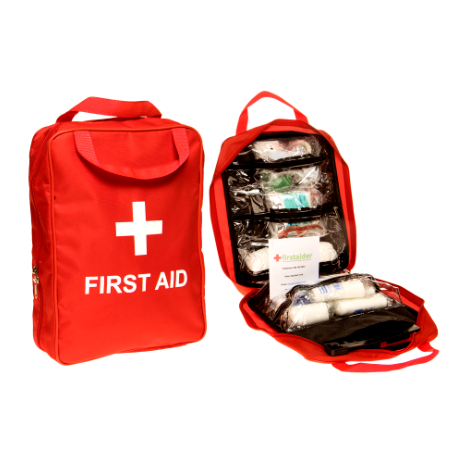In the realm of workplace and public safety, being prepared for an emergency isn't just a recommendation—it's an unyielding mandate. Businesses, healthcare facilities, and myriad other public venues must maintain stringent safety standards to ensure the welfare of employees, patrons, and the public. Central to these provisions are first aid regulations and the vital components they specify.

Understanding Regulation 3 First Aid Kits
The Health and Safety (First-Aid) Regulations 1981 in the United Kingdom mandate the provision of adequate and appropriate first-aid devices, facilities, and personnel in the workplace. The scope of these requirements is extensive, stipulating the necessary measures for first-aid provisions based on the number of employees, the nature of the work, and the hazards present.
Definition and Requirements
A 'Regulation 3' first aid kit is the minimum requirement under UK regulations and is intended for low-risk or casual environments where the risk of an incident is minimal. It typically contains basic first-aid supplies suitable for treating minor injuries and ailments. These kits should be present in every workplace, regardless of size, where a risk assessment indicates this is necessary, and loaded with regular stock subsumed under the British Standard 8599-1. This standard took over the role of kits classified as 'first-aid boxes' under the UK's revised Health and Safety (First-Aid) Regulations 1981.
Importance of Compliance
Compliance with the contents and readiness of Regulation 3 first aid kits is not a trivial matter. It underscores an employer's responsibility to safeguard their employees against any foreseeable set of circumstances that could result in harm. Furthermore, it aligns with the overarching aim of instilling a culture of safety within the organisation, reflective of the business's regard for both letter and spirit of the law in the workplace.
Contents of a Comprehensive First Aid Kit
When assembling a first aid kit, particularly for environments such as schools, it's essential to include a variety of products to ensure preparedness for a wide range of injuries. At the heart of any first aid kit, you would expect to find sterile items such as first aid dressing, including gauze swabs and cotton wool, critical for the initial treatment of wounds. Aid dressing items are fundamental in managing cuts, abrasions, and other minor injuries effectively.
A large aid kit should ideally be housed in a white metal box or a metal box to ensure durability and protection of the contents from environmental factors. The bag within should contain items like safety pins and tags for securing dressings and identifying items quickly. CPR mouth barriers or shields are also a vital product, providing protection during resuscitation efforts.
For injuries requiring immobilisation or support, including a plaster roll 25mm x 3m ensures you can swiftly address these needs. This product, along with others in the kit, should be regularly reviewed to maintain sterility and effectiveness.
To find and view a comprehensive list of products for a well-equipped first aid kit, and to review recommendations and feedback on these items, educational institutions and organisations can consult health and safety guidelines specifically tailored to their needs.
When Are Regulation 3 First Aid Kits Needed?
The applicability of Regulation 3 first-aid kits is as broad as it is vital.
Healthcare Settings
Hospitals, clinics, and medical practices are not exempt from first-aid requirements, and Regulation 3 kits could be a crucial supplement to more specialised medical equipment, especially in areas where immediate medical interventions are required.
Workplace Environments
In less hazardous working environments, it is common to see Regulation 3 first-aid kits employed—placements range from office settings to retail establishments. These kits are tailored to provide prompt attention to everyday accidents that are an inevitable part of workplace scenarios.
Small Businesses and Legal Obligations
Start-ups and small enterprises might regard the requirement for first aid kits as more red tape than necessary preparation. However, ignoring these mandates can invite a host of legal and financial ramifications should an unfortunate incident occur.
Benefits of Regulation 3 First Aid Kits
Beyond mere statutory compliance, the presence of these kits brings with it a multitude of advantages—especially when it comes to managing health emergencies in the workplace.
Quick Access to Essential Medical Supplies
A well-stocked Regulation 3 kit ensures that immediate care can be administered at the onset of an accident or injury. Quick response is often the linchpin in preventing a minor incident from escalating into a major health concern.
Compliance with Safety Regulations
Adhering to Regulation 3 standards reflects a conscientious approach to safety and a willingness to meet duty-of-care responsibilities, reassuring stakeholders and contributing to a positive health and safety culture.
Enhanced Emergency Response
The availability of Regulation 3 first-aid kits significantly enhances the speed and efficacy of emergency responses, minimizing downtime and preserving the general sense of welfare amongst employees and visitors.
Tips for Maintaining Regulation 3 First Aid Kit
Ensuring that your first-aid kits are Regulation 3 compliant doesn't end with initial setup.
Regular Inspections and Restocking
Frequent checks to assess and replenish supplies are key. It's integral that the kit never falls short of any essential items. A regular schedule for these inspections, perhaps tied to broader health and safety site surveys, can be invaluable.
Training on Kit Usage
Employees need to not only know where the first aid kits are located but how to use them. In addition to identifying kit placement, conducting periodic training helps staff feel more confident in their ability to provide assistance when required.
Compliance Documentation
Keep meticulous records. Document each kit inspection, restock, and all relevant first-aid training sessions. Clear and consistent records serve as tangible evidence of your commitment to safety and compliance.
How to Purchase Your Regulation 3 First Aid Kit
For those interested in ensuring the safety and compliance of their work environment, purchasing a Regulation 3 First Aid Kit is straightforward. Visit our website to view our range of products tailored to meet various regulatory requirements. You can easily download detailed product information and specifications to make an informed choice. Once you've selected the appropriate product, simply add it to your cart. For any inquiries or further assistance, don't hesitate to contact our customer service team through the website. Our aim is to provide you with a seamless shopping experience, from cart add to checkout.

Conclusion
Regulation 3 first aid kits represent the first line of defence against workplace injuries and medical emergencies. They signify a commitment to employee well-being, legal responsibility, and an organisational culture prioritising safety. Ensuring that these kits are not only present but well-maintained is an investment in the health, morale, and efficiency of any workplace. By staying proactive and informed about the requirements and benefits of Regulation 3 first aid kits, you stand to create a safer and more resilient environment for all.
